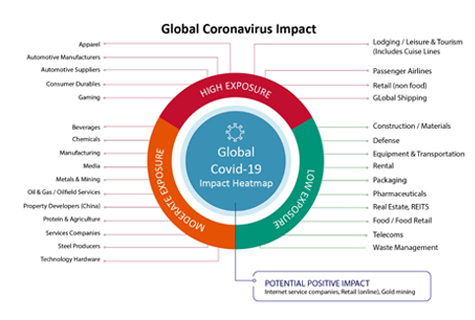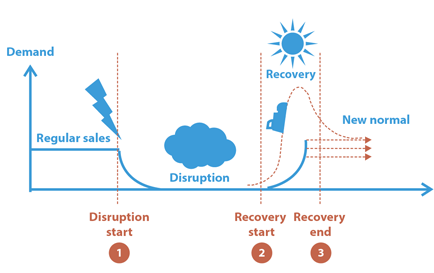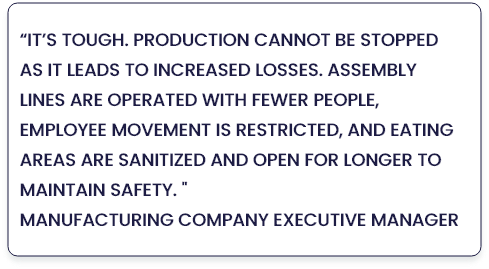Blog
How expensive are even temporary
business shut downs?
Mar 28, 2021 | COVID 19
New ideas to protect against shutdowns

It’s a cost that grew daily beyond the initial days of lockdown.
Worldwide manufacturing businesses believed that the business shutdown was temporary and that the cost impact for limited days of lockdown could easily be absorbed by existing safety margins. However, when the lockdown stretched on for months across the world, it had a devastating impact on supply chains, labour pools and production cycles; making almost every business contingency plan redundant. The extended lockdown placed a heavy financial strain on the manufacturing industry with over 111 million manufacturing enterprises at risk globally.

the lockdown stretched on for months across the world, it had a devastating impact on supply chains, labour pools and production cycles; making almost every business contingency plan redundant. The extended lockdown placed a heavy financial strain on the manufacturing industry with over 111 million manufacturing enterprises at risk globally. In a comparison of production output between December, 2019 and June, 2020 across 62 countries, which account for around 90 per cent of world manufacturing.
It’s a cost that grew daily beyond the initial days of lockdown.

Even as the global economy hesitantly opens, COVID19 infections remain an active overhanging threat for manufacturing shutdowns. A single infection event can have a cascade effect on the profitability and performance recovery of the entire business as well as associated businesses. Consider for example the effect a COVID19 infection-related shutdown can have on a goods manufacturing business earning an average Profit After Tax PAT over Sales of 24% p.a., or about 2% monthly. Should this critical event force
the factory production cycle to shut down for a month, the estimated loss is not just the PAT of 2% for the month of shutdown but the entire sunk cost in terms of wages, inventory and operating costs for the disruption and recovery period. In effect, this cost loss could easily wipe out the business’stotal profit for the year or even the next. To compensate, post the resumption of production operations, business sales would have to ramp up for lost time and may actually be less than expected, with growth indices in negatives or zero at best. The manufacturing business leadership might then be forced to choose strategic options including cost reductions with workforce pay cuts, higher revenue targets or survival led deep cuts in operations, product lines and workforce numbers. A recent example of how a successful and dispersed manufacturing business can still be hit by COVID19 infection is the case of Top Glove – considered as one of the world’s biggest producers of rubber gloves. In late November 2020, following instructions from the Malaysian health authorities, 28 Top Glove factories and sites were totally or partially shut down to screen over 5,700 workers for COVID19, with over 2,500 workers testing positive. The knock-on effect resulted in a drop in global PPE production and rubber uptake in Malaysia. In December 2020, another case of knock-on shutdown was reported in the United Kingdom when the Bakkavor Tilmanstone salads factory, a fresh food supplier to store chains like Marks & Spencer, was hit hard by the virus with two fatalities and almost one in 10 employees testing positive.
Temporary shutdowns can have other cost implications too.
While the most direct cost impact of a temporary shutdown would be on the turnover numbers and restart costs, many businesses tend to forget
the indirect associated costs. These could take the form of customers switching to alternatives or deferring purchases, permanent loss of market share to more resilient competitors, reputation damage amongst investors and suppliers and, most importantly, a drain away of labour force due to morale and future job security
implications.

How effective are current shutdown-risk mitigation methods?
While the world waits for the rollout of vaccines to take effect, businesses are racing to incorporate new crisis management protocols that can protect operations against costly all- unit shutdowns. This is evident in the ad hoc adoption of any potentially useful policy or technology that is available, across all areas of manned operations – on shop floors, assembly lines, cafeteria, entry points and even parking bays. Some of these key employee- exposure monitoring and infection mitigation methods include Thermal Imaging (TI) entry protocols, contact-less technologyand app based self-reporting systems. While many of these stop-gap systems offer quick rollout and adoption, with minimal business investment costs, they often suffer from foundational efficacy flaws. The recent past has seen a plethora of vaunted country app, deployment fails or abandonment, for reasons ranging from employee data privacy concerns and workplace device-carriage restrictions to lack of self-reporting and self-defeating mobile app parameters. Some direct monitoring technologies like Thermal Imaging have time specific, single point coverage,which not only caused personnel traffic choke points but are also incapable of data analysis and trace-back
functionality. While there is no denying that carefully structured sanitisation, hygiene and
social distancing protocols can reduce infection risks, when stakeholders are diligent, it may
still not safeguard a staffed business, factory floor or office complex from an infectious
spread. The reality is that anything from forgetfulness to network issues may restrict the
effectiveness.
Now, it’s time for a protective solution with unmatched real time warning and quick response advantages.
Invest in the increased security and responsiveness of TracePlus. This adaptive and intelligent Contact Tracing Technology is far quicker at safeguarding your workspace from the risk of rampant COVID19 spread than almost any other solution available. It mitigates costly total shutdowns with its near real time speed of response. The nominative device-based technology does not depend on the user for activation, is easily deployable in 48 hours, non-intrusive and operates automatically. An advanced contact tracking system, with a one-meter radius of sensitivity, it traces all workforce interactions and distancing, to create meaningful data with alerts. This allows business management to have a guardian solution with lightning-fast response times that help identify, isolate and contain COVID19 outbreaks or risk points, through behaviour, affected individuals, or groups.
The constant traffic view and interactive oversight of TracePlus, creates confidence among management and employees that the business can be event responsive and continue operating without the fear of a costly total shutdowns or unmanaged risk to health. Beyond COVID19 risk mitigation, the advanced TracePlus ability of tracking employee interactions with locations and peers opens up a new world of useful applications, from tighter security bubbles to optimization of human resource allocations. Giving business management a powerful future-proof tool that enables greater management, productivity and peace of mind.
